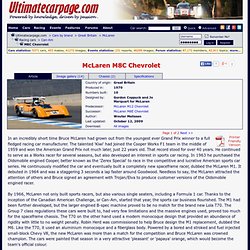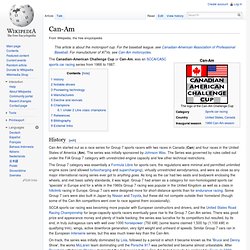

Bruce McLaren. Bruce McLaren's Can-Am incredible sound. Can-Am 1972 Part 2. Can-Am 1972 Part 1. Can Am Supersports - Big Banger V8 - McLaren M8F - Good Sound & Backfire. 68' Can-Am McLaren M6B at Road America Jim Pace 7-11-final.mov. Can-Am Cars 2008-Monterey Historics. Can-Am History of McLaren. When you hear the name McLaren today, you think of Formula One, but in the late ’60s and early ’70s everyone thought “Can-Am”.

New Zealander Bruce McLaren formed Team McLaren in the mid-1960s. His goal was to win the F1 World Driving Championship in a car of his own design. But Bruce was also racing in US sports car events, so when the Can- Am came along in 1966, with its huge (for the time) purses, Team McLaren went after it, too. For the inaugural Can-Am season, Team McLaren built and raced the McLaren M1B, an Oldsmobile powered, tube frame chassis sports car, which was an evolution of the M1A they had run in sports car races the year before.
Two team cars were entered for Bruce and fellow countryman Chris Amon. In 1967, McLaren switched to 6-liter iron-block Chevy V8s and aluminum monocoque chassis construction for the team’s M6A racers. While the M1 and M6 racers had rounded bodywork, which was the norm at the time, McLaren’s 1968 car, the M8A, was more of a wedge shape. The Trust's M8A: Articles. The World's Fastest Sports Car Bruce McLaren has his sights set on the ‘69 Can-Am series and the accompanying American dollar.

His quest for the ultimate sports car has resulted in the new M8A monocoque. After winning the 1967 Can-Am series in his all-conquering M6A Chevy-powered sports car, Bruce McLaren went back to his factory at Colnbrook, near London Airport, and set about designing a car that was even quicker. Why? Because in the race at Riverside Jim Hall’s Chaparral had proved to be closely competitive, and McLaren knew he would have to have a better car for 1968. Suspension and general styling are obviously similar to the previous car, although the body shape has been smoothed out a lot, and the general ‘negative lift’ lines of the new body means that the currently popular ‘wing’ isn’t really necessary. Slots cut in the back of the front wings relieve the high-pressure area directly over the front guards. The M8A is powered by a special aluminium 7-litre Chevy V8. 1970 McLaren M8C Chevrolet - Images, Specifications and Information.
Page 1 of 2 Next >> In an incredibly short time Bruce McLaren had grown out from the youngest ever Grand Prix winner to a full fledged racing car manufacturer.

The talented 'Kiwi' had joined the Cooper Works F1 team in the middle of 1959 and won the American Grand Prix not much later, just 22 years old. That record stood for over 40 years. He continued to serve as a Works racer for several seasons, but also developed an interest in sports car racing. In 1963 he purchased the Oldsmobile engined Cooper, better known as the 'Zerex Special' to race in the competitive and lucrative American sports car series. By 1966, McLaren not only built sports racers, but also various single seaters, including a Formula 1 car. While Trojan began the production of the M6B customer cars, the small McLaren engineers worked ferociously to keep the edge over the competition.
Can-Am. The Canadian-American Challenge Cup or Can-Am, was an SCCA/CASC sports car racing series from 1966 to 1987.

History[edit] Can-Am started out as a race series for Group 7 sports racers with two races in Canada (Can) and four races in the United States of America (Am). The series was initially sponsored by Johnson Wax. The Series was governed by rules called out under the FIA Group 7 category with unrestricted engine capacity and few other technical restrictions. 1969 McLaren M8B Can-Am - Can-Am Cars LTD.
1971 Can-Am Watkins Glen Part 1. McLaren Picture Page.